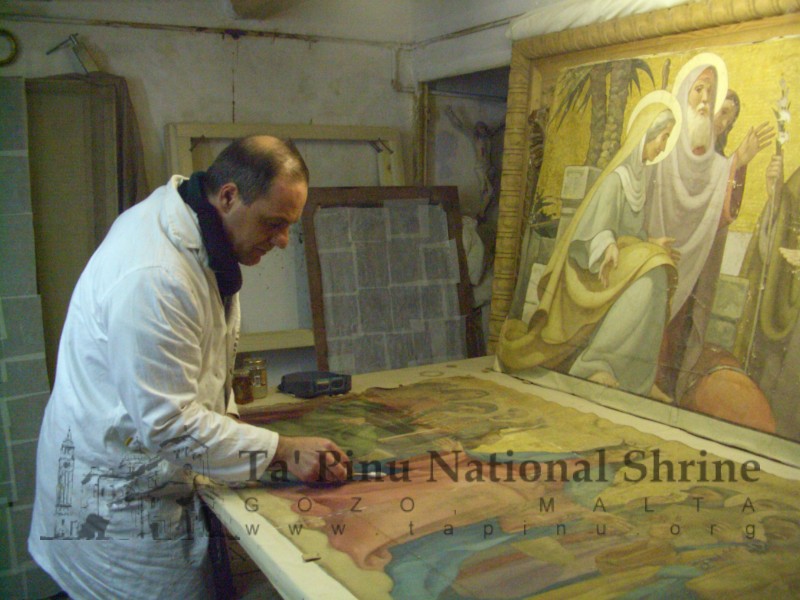Conservation work on the paintings of Giuseppi Briffa
By Canon Charles Vella
Artist, conservator and restorer of art
Six paintings by Giuseppe Briffa in the Ta’ Pinu Sanctuary are now ready from the process of conservation and restoration. This means that the project is now half way through as to conservation and restoration of all the paintings by Giuseppi Briffa which make part of the collection of preparatory paintings for the mosaics found in this national sanctuary.

In these first paintings, which are of considerable size (five feet by eight) have always in the middle the figure of the Virgin Mary seated on a throne and sometimes surrounded either by martyrs or apostles or angels or other groups forming part of the Litany that calls the Virgin Mary a blessed queen among other attributions given to her. Six other paintings show episodes from the life of the Virgin.
These works reflect the epoch in which they were made, that is, the second part of the twentieth century with their peculiar style and they compliment the majestic and beautiful temple that was built in honour of the Virgin Mother of God in the Romanesque style. They are designed with a certain docility and grace and with the use of clean colours on the basis of the tempera, and are therefore not painted on oil.
The paintings never had varnish applied to them in the final stages by the artist himself as is the usually the case with other paintings; the colours used for them contain a mixture of colours together with water. The elements were the main cause of the damage that they have suffered as time unfolded since they were conserved in places which were definitely not the ideal. The process of conservation was therefore not easy especially because they lacked the protective varnish.
Different methods were applied before the right solvent was found. It seems that the consistence of colours varies from one painting to the other and so that which may appear as a solution in one painting may not be the case in the next one.
The results on these first six paintings that have been restored have proved positive. Now that the process has come to an end, the visitor may be able to appreciate better their original beauty.
The second part of the process was the strip lining; this means that a new lining has been applied to the sides and edges of the paintings in such a manner that they can now be attached to different backgrounds through mechanical expansion which renders easier and more elegant the finished product.
This process is also very delicate. This is due to the fact that the original frame-cloth which has as its basis a cotton canvas is not friendly with any liquid whatsoever because it drains and can affect a deformation on the original canvas. Any liquid which does not undergo evaporation as some solvents used to clean the painting, may damage the colours or even cause movement. After professional consultations from institutional authorities, it was decided that the best glue of irreversible nature should be synthetic with a consistent gel form that evaporates and provides adhesion of a certain strength that would help the canvas to be taken off together with the framework.
At the end a pictorial integration will be established especially where there are residues of mould that do not go away during the cleaning process. Now we are also finding some problem where the mould is acidic or penetrates colour as well as where colours have lost their brightness due to the elapsing of time. These have to be integrated in the same manner in order to obtain pictorial harmony.
Even if these paintings never had varnish applied to them, now this will be necessary after the intervention of the cleaning process for reasons of protection. There are various qualities of varnish and the best now has to be found and applied. A durable type of varnish has to be applied. When this is applied, there will be no need of it being taken away in the future due to deterioration. The best professional products in the market are to be used.
I would like to end this report which is addressed specifically to the public in general by encouraging those who frequent the Sanctuary to appreciate these beautiful paintings which our forefathers have left us and which are of high artistic value. It was a wise decision of the administrative equip of the Ta’ Pinu Sanctuary to have these paintings restored and hopefully within a few months, everybody will be able to admire the artistic beauty of these treasures.



















































